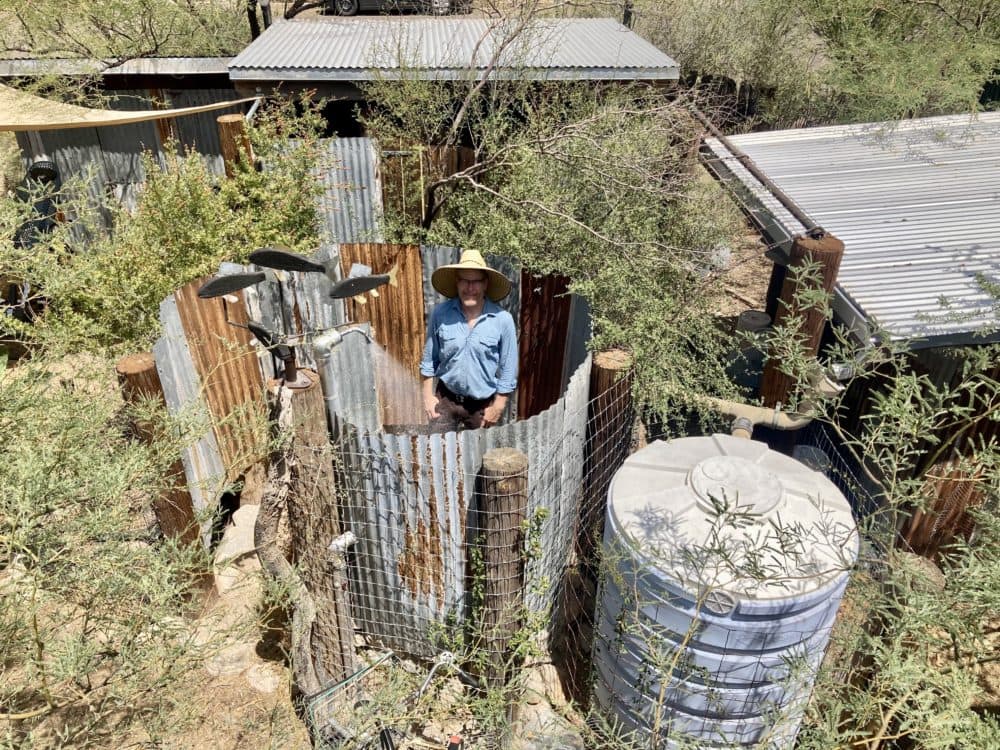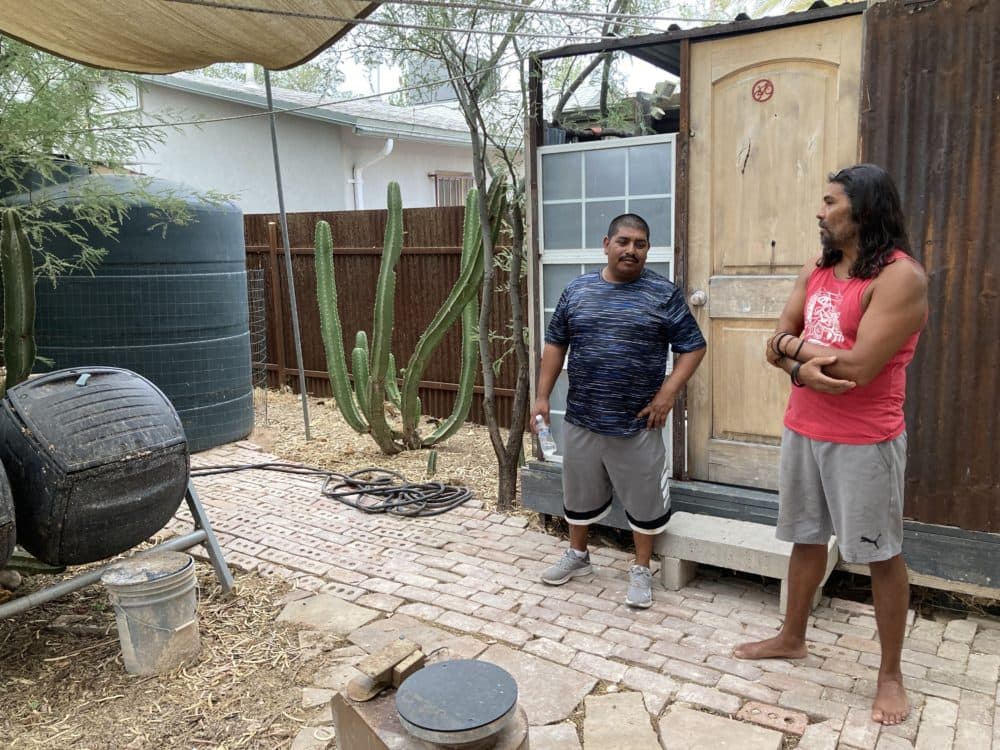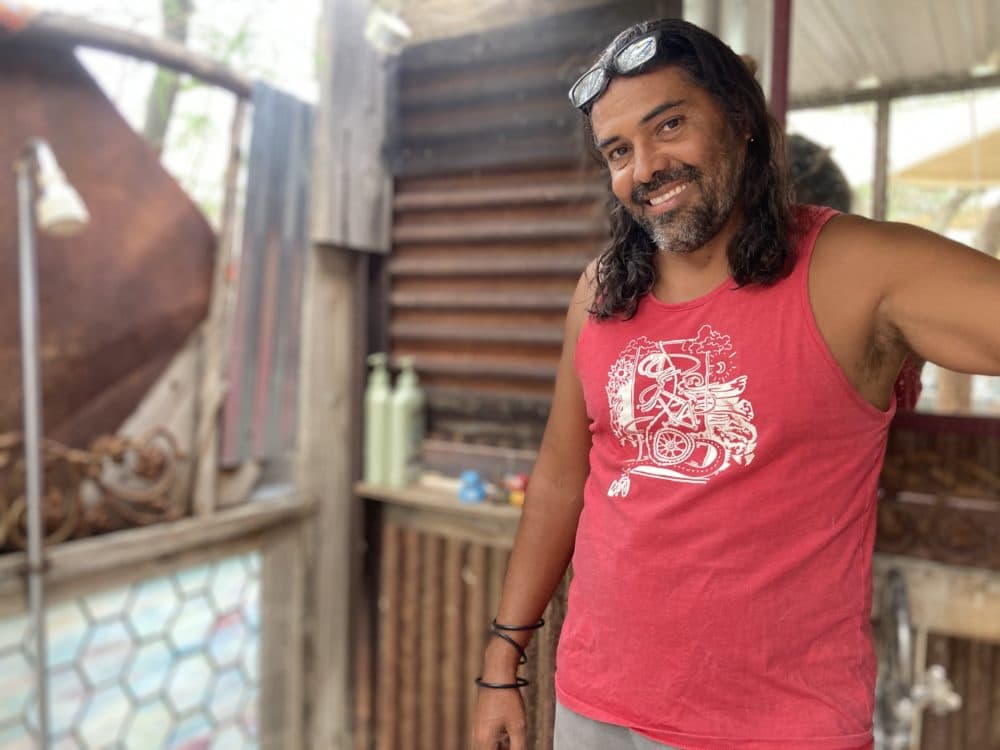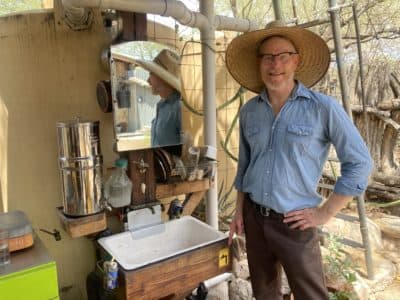Advertisement
When it rains in the desert, it pours. Why not capture all that water?
Resume
This segment was broadcast on Nov. 25, 2022. Click here for that audio.
With the Western United States stuck in a 22-year drought, some residents of Tucson, Ariz., have a secret to surviving in the desert.
They’re harvesting rainwater.
Evaristo Ramirez Barajas is one of them. Despite the sweltering desert heat, his yard is shaded with mesquite trees, creosote and cacti.
“It's been not a good season for Tucson,” Barajas says. “We've been struggling with this monsoon a lot, but even [with] that, we still have water.”

Bajaras has installed a 1,000-gallon rainwater tank in his yard, and his plants get a boost from the system. When it rains, the water flows from his roof into a gutter that leads to the tank. He uses a hose attached at the bottom to irrigate the trees.
The system is also one way that Barajas makes money. He’s part of a small company called the Tucson Rainwater Harvesting Co-op. Barajas and other members have been installing tanks for a few years now and the ongoing drought has been good for business.
The city of Tucson has been helping, too. The water department offers a rebate for rainwater harvesters. A resident who buys a 1,000-gallon tank will get a check for $1,000.
“I think the potential is huge,” says James MacAdam of the city’s water department. “I think about parts of Australia, which 15 years ago, rainwater harvesting was illegal. And then they underwent a massive drought and now it's mandatory in a lot of the cities.”
In Tuscon, 90% of the city’s water comes from the Colorado River. Harvested rainwater is literally a drop in the bucket.

Evaristo Barajas, from the Tucson Rainwater Harvesting Co-op, shows off his outdoor shower. It uses water collected from the rain. (Peter O'Dowd/ Here & Now)But MacAdam says homeowners with rain tanks save about a month's worth of city water every year on average. It won't solve a water crisis, but MacAdam says that as the climate gets hotter and drier, harvesting the rain will play a bigger role “because it's one of our largest untapped sources of water.”
With each month of a 22-year drought, the need gets more urgent. In June federal officials warned states that use the Colorado River to get serious about cutting back. Arizona's legislature also just approved spending $1 billion to find new sources of water. Some of the money will go to supporting rain harvesting, which Brad Lancaster spends his life thinking about.

In the mid-'90s, Lancaster and his family joined with a group of neighbors who wanted to bring the neighborhood to life with more trees. Summer monsoon rains would release torrents of water that flowed “like an ephemeral creek” down the street, Lancaster says.
The neighbors tried diverting the deluge off the street, even going so far as to cutting the curb so the rainwater could flow on the trees.
Now after years of work, Lancaster's entire street is covered with mature desert shade trees. But Lancaster didn’t stop there. Over the course of a year, 95% of Lancaster's water is captured rain.
“We have not had a substantial rain since the end of December,” Lancaster says. “Here we are in July and I am still drinking, cooking and bathing with rainwater. I think that's pretty good!”
But Lancaster says with dire shortages on the Colorado River, it’s frustrating to see no one taking action.
“As the reservoirs of Lake Mead and Lake Powell are dropping very fast, people are still bickering about who should conserve water and or they're trying to get water from elsewhere,” says Lancaster.
Lancaster says the solution could be to use the rainwater, which is already available, and to make rainwater a primary water source, using groundwater or water from the Colorado River, as a backup.
“If you start now while you've got all options on the table, you've got time to learn,” he says. “It becomes easier.”
Rain harvesting is still a lot of work, however, and the tanks cost money. Eravisto Barajas from the Tucson co-op says installing a large tank runs about $1,500.
Of the 40 million people who rely on the Colorado River, not all would choose to live the way Lancaster and Barajas do. But they’re among those thriving in the desert, untethered to the fate of a troubled river.
Peter O'Dowd produced and edited this interview for broadcast with Ciku Theuri. Jeannette Muhammad adapted it for the web.
This segment aired on July 22, 2022.

